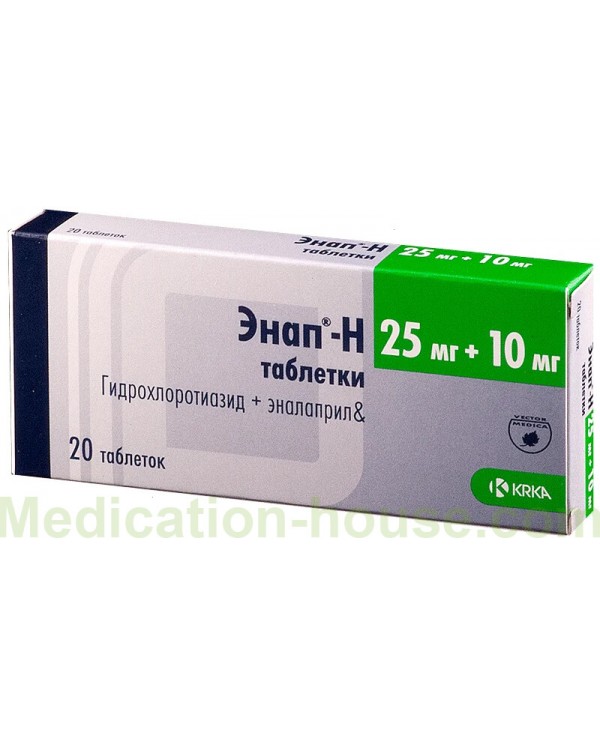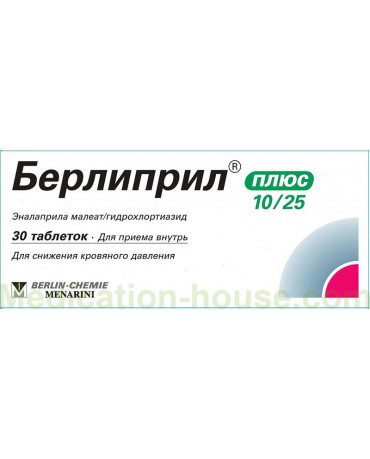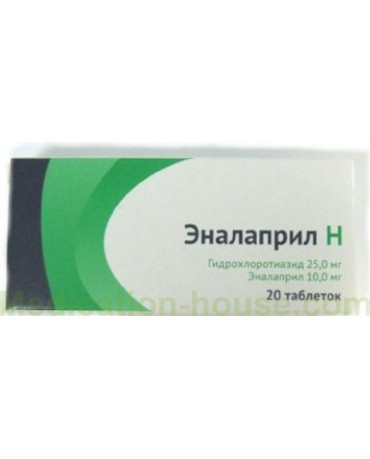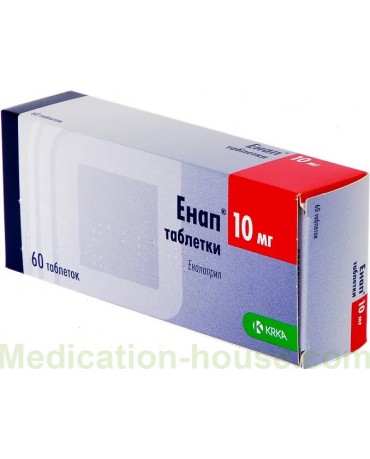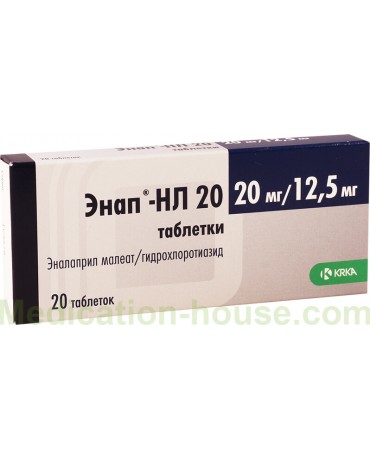Instruction for Enap-H
Reed more and buy Enap-H on this page
Enap-H is a combined antihypertensive agent.
Release form and composition
Dosage form Enap-H - tablets: round, flat, with a beveled edge, yellow, with a risk on one side (10 pieces in a blister, 2, 3, 6 or 9 blisters are packed in a cardboard box).
Composition of 1 tablet:
active substances: hydrochlorothiazide - 25 mg, enalapril maleate - 10 mg;
auxiliary components: corn starch, lactose monohydrate, magnesium stearate, anhydrous calcium hydrogen phosphate, sodium bicarbonate, talc, quinoline yellow dye (E104).
Pharmacodynamics
The action of Enap-H is due to the effects of its active substances - hydrochlorothiazide and enalapril.
Hydrochlorothiazide is a moderately potent thiazide diuretic. Blocks carbonic anhydrase in the proximal convoluted tubule. Reduces the reabsorption of sodium ions at the level of the cortical segment of the loop of Henle (the part of the renal tubule that forms a loop going in the direction of the center of the kidney), while not affecting its section, which passes in the medulla of the kidney. Virtually no effect on the acid-base state. Retains calcium ions in the body. Increases the excretion of magnesium ions. Enhances the excretion of potassium ions, phosphates and hydrocarbons by the kidneys. By reducing the volume of circulating blood (BCC) and changes in the reactivity of the vascular wall, it reduces blood pressure (BP).
The diuretic effect of hydrochlorothiazide develops within 1-2 hours after ingestion, reaches a maximum after 4 hours and lasts for 10-12 hours. The effect decreases with a decrease in the glomerular filtration rate and stops altogether when its value is less than 30 ml / minute.
Enalapril is an angiotensin-converting enzyme (ACE) inhibitor. Converts angiotensin I to angiotensin II. Reduces the concentration of aldosterone in the blood. Suppresses the sympathetic nervous system. Improves the functioning of the kallikrein-kinin system. Increases the release of renin by juxtaglomerular cells in the walls of the arterioles of the renal glomeruli. Stimulates the release of endothelial relaxing factor and prostaglandins. The specified effects of enalapril in the aggregate eliminate spasm, expand peripheral arteries, and also reduce systolic and diastolic blood pressure, total peripheral vascular resistance, pre- and afterload on the myocardium. Enalapril dilates arteries to a greater extent than veins, while not affecting the change in heart rate (HR). Improves blood supply to the ischemic myocardium. The antihypertensive effect is more pronounced in patients with a high concentration of renin in the blood plasma than with a normal or low one. When taken in therapeutic doses, enalapril does not affect cerebral circulation. Increases renal blood flow without altering the glomerular filtration rate (however, the rate usually increases in patients with initially decreased glomerular filtration).
The maximum effect of enalapril develops within 6-8 hours and lasts up to 24 hours.
The combination of enalapril and hydrochlorothiazide contributes to a more pronounced decrease in blood pressure than each of the drugs separately, and also allows you to maintain the effect for at least a day.
Pharmacokinetics
Hydrochlorothiazide is absorbed mainly in the proximal small intestine and duodenum. Absorption averages 70%, with simultaneous food intake increases by 10%. The drug reaches its maximum serum concentration within 1.5–5 hours. Bioavailability - 70%. Communication with plasma proteins - 40%. The volume of distribution is about 3 l / kg. In the therapeutic dose range, the average AUC (area under the pharmacokinetic curve) increases in direct proportion to the dose increase.
When taking hydrochlorothiazide 1 time per day, there is a slight accumulation of the substance. The drug crosses the blood-placental barrier and into breast milk. Accumulates in amniotic fluid. The concentration in the serum of the umbilical vein is practically equal to the concentration in the maternal blood; in the amniotic fluid - approximately 19 times.
Hydrochlorothiazide is not metabolized in the liver. It is excreted mainly by the kidneys: unchanged - about 95%, in the form of hydrolyzate-2-amino-4-chloro-m-benzenedisulfonamide - about 4% (by glomerular filtration and active tubular secretion in the proximal nephron). Renal clearance is approximately 5.58 ml / s (335 ml / min). The substance has a two-phase elimination profile: the half-life (T½) in the initial phase is 2 hours, in the final phase (10–12 hours after administration) - 10 hours.
In elderly patients, hydrochlorothiazide increases the concentration of enalaprilat, but does not adversely affect its pharmacokinetics. In patients with chronic heart failure (CHF), the absorption of hydrochlorothiazide decreases in proportion to the degree of development of CHF - by 20–70%, and the T½ period increases to 28.9 hours. Renal clearance - 0.17–3.12 ml / s, or 10– 187 ml / min (average value - 1.28 ml / s, or 77 ml / min).
In patients who have undergone intestinal bypass surgery due to obesity, it is possible to reduce the absorption of hydrochlorothiazide by 30% and serum concentration by 50% (compared with healthy volunteers).
Enalapril is absorbed by 60% after oral administration. Food does not affect absorption. It is metabolized in the liver to form enalaprilat - an active metabolite, which is a more effective ACE inhibitor than enalapril. It binds to plasma proteins by 50-60%. Enalapril reaches maximum concentration within 1 hour, enalaprilat - 3-4 hours. The metabolite easily penetrates the histohematogenous barriers, with the exception of the blood-brain. In small quantities, it crosses the placenta and into breast milk. It is excreted: by the kidneys - about 60% (of which 40% - in the form of enalaprilat and 20% - in the form of enalapril), through the intestines - about 33% (of which 27% - in the form of enalaprilat and 6% - in the form of enalapril). The T½ period of enalaprilat is 11 hours. The renal clearance of enalapril and enalaprilat is 0.005 ml / s (18 l / h) and 0.00225–0.00264 ml / s (8.1–9.5 l / h), respectively.
Enalapril is removed by hemodialysis (flow rate 38 to 62 ml / min) and peritoneal dialysis. The serum concentration of the drug after a 4-hour hemodialysis is reduced by 45-57%. The rate of excretion decreases in the case of reduced renal function, therefore, such patients (especially with severe renal failure) require a decrease in the dose of Enap-H.
It is possible to slow down the metabolism of enalapril in patients with hepatic insufficiency, but its pharmacodynamic effect does not change.
In patients with CHF, the absorption and metabolism of enalaprilat slows down, and the volume of its distribution decreases.
Enalapril and hydrochlorothiazide used in combination do not interfere with each other's pharmacokinetics.
Indications for use
According to the instructions, Enap-H is prescribed for arterial hypertension in cases where monotherapy was not effective enough.
Contraindications
Absolute:
stenosis of an artery of a solitary kidney or bilateral stenosis of the renal arteries;
severe renal dysfunction (creatinine clearance less than 30 ml / min);
anuria;
lactose intolerance, lactase deficiency or glucose-galactose malabsorption;
hereditary or idiopathic angioedema;
a history of angioedema caused by the use of ACE inhibitors;
age under 18;
pregnancy and lactation;
hypersensitivity to the components of Enap-H or sulfonamide derivatives.
Relative:
severe stenosis of the aortic opening;
idiopathic hypertrophic obstructive subaortic stenosis;
severe autoimmune systemic diseases of the connective tissue (for example, scleroderma or systemic lupus erythematosus);
severe atherosclerosis;
chronic heart failure;
coronary artery disease;
cerebrovascular diseases (including cerebrovascular insufficiency);
impaired liver and / or kidney function (creatinine clearance 30–75 ml / min);
hyperkalemia;
diabetes;
oppression of bone marrow hematopoiesis;
condition after kidney transplantation;
conditions accompanied by a decrease in the volume of circulating blood (including vomiting and diarrhea, restriction of salt intake due to the use of diuretics);
elderly age.
Instructions for use Enap-H: method and dosage
Enap-H should be taken orally, during meals or immediately after a meal, once a day, at the same time, preferably in the morning. The tablets must be swallowed whole and washed down with a sufficient amount of liquid.
Adults are prescribed 1 tablet per day.
The duration of treatment is determined by the doctor individually.
Renal function should be examined before starting therapy.
When transferring to Enap-H a patient who received diuretic therapy, they should be canceled or the dose reduced at least 3 days in order to prevent the development of symptomatic hypotension.
In case of renal failure, titration of doses of hydrochlorothiazide and enalapril separately is required. As soon as they correspond to similar doses in Enap-H, you can make a replacement.
Side effects
Side effects are classified as follows: very often -> 1/10, often - from> 1/100 to <1/10, infrequently - from> 1/1000 to <1/100, rarely - from> 1/10 000 to < 1/1000, very rarely - <1/10 000, including individual messages.
allergic reactions: infrequently - Stevens-Johnson syndrome; rarely - Quincke's edema; very rarely - intestinal angioedema;
from the central nervous system: very often - weakness, dizziness; often - asthenia, headache; infrequently - drowsiness or insomnia, paresthesia, tinnitus, hyperexcitability;
from the side of metabolism: infrequently - gout;
from the digestive system: often - nausea; infrequently - abdominal pain, dyspepsia, flatulence, vomiting, dry mouth, constipation, diarrhea; rarely - cholestatic jaundice, fulminant necrosis;
from the genitourinary system: infrequently - impaired renal function, acute renal failure;
on the part of the cardiovascular system: often - orthostatic hypotension; infrequently - palpitations, chest pain, marked decrease in blood pressure, fainting, tachycardia;
on the part of the hematopoietic system: rarely - thrombocytopenia, neutropenia, leukopenia, decreased hematocrit and hemoglobin, inhibition of bone marrow function;
from the musculoskeletal system: often - muscle spasms; infrequently - arthralgia;
from the respiratory system: often - cough; infrequently - shortness of breath;
from the reproductive system: infrequently - decreased libido, impotence;
dermatological reactions: infrequently - increased sweating, alopecia, itching, skin rash, skin necrosis;
on the part of laboratory parameters: rarely - an increase in the activity of bilirubin and hepatic transaminases, an increase in the concentration of creatinine and urea in the blood serum, hyperglycemia, hyperkalemia, hypokalemia, hyponatremia, hyperuricemia;
others: very rarely - a symptom complex, including skin rash, vasculitis, myalgia and arthralgia, fever, leukocytosis, eosinophilia, serositis, a positive test for antinuclear antibodies.
Overdose
Symptoms: a violation of the acid-base and water-electrolyte balance of the blood, a marked decrease in blood pressure with bradycardia or other heart rhythm disturbances, impaired consciousness (including coma), increased diuresis, acute renal failure, convulsions.
In case of an overdose, the patient should be transferred to a horizontal position and his legs should be raised. In mild cases, it is necessary to flush the stomach and take activated charcoal. For more serious violations, measures are taken to stabilize blood pressure: plasma substitutes are injected intravenously, sodium chloride solution 0.9%. During treatment, it is necessary to monitor blood pressure, respiration and heart rate, urine output, serum concentration of electrolytes, creatinine and urea. If necessary, angiotensin II is administered intravenously, hemodialysis is performed.
Special instructions
Arterial hypotension
In the following cases, after the first administration of Enap-H, arterial hypotension may develop with all its clinical consequences: severe heart failure and hyponatremia, arterial hypertension, left ventricular dysfunction, severe renal failure. The risk is especially high in patients who have concomitant hypovolemia, including due to hemodialysis, vomiting, diarrhea, salt-free diet, or diuretic therapy. Arterial hypotension that develops after taking the first dose is not a contraindication for continuing therapy.
Violations of water and electrolyte balance
During treatment, it is necessary to systematically monitor the serum electrolyte concentration, especially in patients with prolonged diarrhea or vomiting, in order to identify possible imbalances in time and take appropriate measures.
The following symptoms may indicate a violation of the water-electrolyte balance while taking Enap-H: drowsiness, weakness, increased excitability, thirst, dry mouth, oliguria, tachycardia, decreased blood pressure, convulsions (mainly of the calf muscles), myalgia, gastrointestinal disorders (nausea, vomiting).
Hepatic dysfunction
Enap-H should be used with caution in the treatment of patients with progressive liver disease or liver failure, since hydrochlorothiazide can contribute to the development of hepatic coma due to even minimal disturbances in water and electrolyte balance. There are isolated cases of acute hepatic failure with cholestatic jaundice, fulminant liver necrosis and even death during treatment with ACE inhibitors. If jaundice occurs or the activity of liver enzymes increases, Enap-H should be discontinued immediately.
Endocrine and metabolic disorders
Patients receiving oral hypoglycemic agents or insulin should be monitored continuously during treatment, since hydrochlorothiazide can weaken their effect, and enalapril can enhance it.
Thiazide diuretics can increase serum cholesterol and triglyceride concentrations.
In some cases, hydrochlorothiazide exacerbates the course of gout and / or aggravates hyperuricemia. However, enalapril, enhancing the excretion of uric acid by the kidneys, counteracts the hyperuricemic effect of a thiazide diuretic.
During the period of therapy with thiazide diuretics, the excretion of calcium by the kidneys may decrease, as a result of which a slight and transient increase in the level of calcium in the blood serum is possible.
Severe hypercalcemia usually indicates latent hyperparathyroidism. Before examining the function of the parathyroid glands, you should stop taking Enap-H.
Allergic / hypersensitivity reactions
Hypersensitivity reactions against the background of the use of thiazide diuretics can occur in patients with no history of allergic reactions. There are known cases of worsening of the course of systemic lupus erythematosus.
The risk of developing anaphylactic reactions increases in patients who undergo hemodialysis using high-flow polyacrylonitrile membranes (AN 69), desensitization procedure to bee or wasp venom, low density lipoprotein apheresis with dextran sulfate. In this regard, it is not recommended to take Enap-H in these cases.
With the development of angioedema of the face, in most cases, it is sufficient to cancel Enap-H and prescribe antihistamines.
Angioedema of the tongue, pharynx or larynx can be fatal. Therefore, during its development, an urgent subcutaneous injection of epinephrine is indicated (0.3-0.5 ml of a solution in a ratio of 1: 1000). It is also necessary to maintain a patency of the airway (tracheostomy or intubation is performed).
In patients of the Negroid race, the incidence of angioedema during therapy with an ACE inhibitor is higher than in patients of other races.
In patients with a history of angioedema, not associated with the use of an ACE inhibitor, when taking enalapril, the risk of developing angioedema is increased.
Cough
One of the side effects of enalapril is a dry and prolonged cough, which disappears after its withdrawal.
In the differential diagnosis of cough, the patient should warn the doctor about taking Enap-H.
Surgical intervention
Patients should inform their doctor about taking Enap-H before surgery, including dental procedures.
With the introduction of drugs that cause arterial hypotension, enalapril can block the formation of angiotensin II in response to the compensatory release of renin. A pronounced decrease in blood pressure in this case can be corrected by an increase in the volume of circulating blood. This should be taken into account when performing surgery and general anesthesia.
Influence on the ability to drive vehicles and complex mechanisms
At the initial stage of therapy, a pronounced decrease in blood pressure is possible, which is accompanied by dizziness and drowsiness, which affects the speed of reactions and the ability to concentrate. In this regard, at the beginning of treatment, it is recommended to refrain from driving and performing potentially dangerous types of work.
Application during pregnancy and lactation
The effect of ACE inhibitors on the fetus when used in the first trimester of pregnancy has not been established. In the II and III trimesters, they have a negative effect. In newborns, it is possible to develop arterial hypotension, hyperkalemia, renal failure, hypoplasia of the skull bones. Presumably, due to impaired renal function of the fetus, there is a risk of developing oligohydramnios (oligohydramnios), which can lead to hypoplasia of the lungs, contracture of the extremities and deformation of the bones of the skull (including its facial part).
Taking diuretics during pregnancy is not recommended, since it is fraught with the development of jaundice of the fetus and newborn, thrombocytopenia and, possibly, other adverse reactions that occur in adults.
Both active ingredients Enap-H pass into breast milk. In this regard, breastfeeding should be discontinued if therapy is indicated during lactation.
Childhood use
The safety of Enap-H components when used in childhood has not been established, therefore, the drug is contraindicated in patients under 18 years of age.
With impaired renal function
Enap-H is contraindicated in severe renal impairment (creatinine clearance less than 30 ml / minute) and anuria.
Caution should be observed when treating patients with moderate renal impairment (creatinine clearance 30–75 ml / minute), bilateral renal artery stenosis or stenosis of the arteries of a single kidney, as well as patients who have undergone kidney transplantation.
For violations of liver function
Enap-H is contraindicated in porphyria.
Caution should be observed when treating patients with severe hepatic impairment.
Use in the elderly
In elderly patients, Enap-H should be used with caution, under close medical supervision.
Drug interactions
Antacids may decrease the bioavailability of enalapril.
Enap-H, when used in combination with lithium preparations, slows down the excretion of lithium, as a result of which it enhances its neuro- and cardiotoxic effect.
Hydrochlorothiazide may enhance the effect of tubocurarine chloride. In combination with glucocorticosteroids or calcitonin, it can lead to the development of hypokalemia.
The use of hydrochlorothiazide in combination with phenothiazine derivatives or narcotic analgesics is fraught with the development of orthostatic hypotension.
Hydrochlorothiazide may reduce the effect of adrenergic agonists (epinephrine).
Alpha and beta blockers, methyldopa, ganglion blockers, slow calcium channel blockers can further reduce blood pressure.
Cyclosporine in combination with enalapril increases the risk of hypercalcemia.
Allopurinol, immunosuppressants and cytostatics in combination with enalapril increase the risk of developing leukopenia.
Ethanol enhances the hypotensive effect of Enap-H, as a result of which orthostatic hypotension may develop.
When using gold preparations (for example, sodium aurothiomalate) during therapy with an ACE inhibitor, there is a risk of developing a symptom complex, including arterial hypotension, nausea and vomiting, flushing of the facial skin.
With the simultaneous use of sympathomimetics, it is possible to reduce the antihypertensive effect of enalapril.
Cholestyramine and colestipol reduce the absorption of hydrochlorothiazide in the gastrointestinal tract by 85% and 43%, respectively.
Non-steroidal anti-inflammatory drugs (NSAIDs), including selective inhibitors of cyclooxygenase-2, can weaken the hypotensive effect of enalapril. Both drugs have an additive (reversible) effect on increasing serum calcium levels, which may lead to impaired renal function, especially in patients with concomitant renal impairment.
With the combined use of NSAIDs, it is possible to reduce the diuretic and antihypertensive effect of hydrochlorothiazide.
According to epidemiological studies, ACE inhibitors in combination with hypoglycemic agents can contribute to the development of hypoglycemia, especially in the first weeks of treatment in patients with impaired renal function. However, in the course of long-term and controlled clinical studies, these data have not been confirmed, therefore there are no restrictions on the use of enalapril in diabetes mellitus, but regular monitoring of the patient's condition is required. When prescribing oral hypoglycemic agents or insulin, their dosage may need to be adjusted.
Potassium supplements, salt substitutes, potassium supplements, potassium-sparing agents can significantly increase serum potassium, especially in patients with renal insufficiency.
Potassium loss due to hydrochlorothiazide is usually reduced by enalapril, and its concentration in serum, as a rule, remains within the normal range.
Terms and conditions of storage
Shelf life - no more than 3 years, provided that the storage conditions recommended by the manufacturer are observed: dry place, temperature up to 25 ° С.
Keep out of the reach of children.
Reviews about Enap-H
According to reviews, Enap-H is an effective antihypertensive drug that rapidly reduces high blood pressure. Many people call its additional advantage its long-term effect, due to which it is necessary to take 1 tablet just once a day.
The disadvantages include a pronounced diuretic effect, the frequent development of such a side effect as a dry cough. There are some reviews that indicate that with prolonged use, Enap-H is addictive.
Terms of sell
You can buy Enap-H without a prescription from a doctor.

